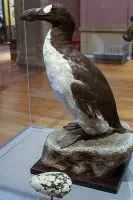The Great Auk (Pinguinus impennis) is an extinct flightless bird. It had quickly disappeared off the face of the earth 200 years ago. While it looked like penguins the great auk never related to present day penguins. It had become extinct in the 19th century.
Adult auks would reach a height of 75 – 85 cm. They weighed as much as 11 pounds. Like most penguins living today, the great auk also had white belly and black back. Auks had 11-cm long bill.
They were found all over the northern Spain, North Atlantic, Greenland, Faroe Islands, Ireland, Canada, Iceland, Norway, Iberian Peninsula, Italy, southern France, Baffin Bay, and Great Britain.
Great auks used to make ha bitats in isolated islands and rocky islands so that the sea foods are easily accessible to them.
bitats in isolated islands and rocky islands so that the sea foods are easily accessible to them.
They had 15 cm long wings. Great auks were remarkable swimmers. They were not as comfortable on land though.
Great auks used to eat fish including shorthorn sculpins, sand lance, lumpsuckers, cod, plankton, capelin, crustaceans, and menhaden.
They used to live in 20 breeding colonies. Great auks were migratory species in that they traveled south in winter.
Auk’s breeding season occurred in May or June. The female would lay only one white egg on a nest built on rocks. Chicks were born after an incubation period of 42 days. Young auks used to leave nest when they reached 14 – 21 days age.
The great auk might have possibly reduced its population in the Late Ice Age.
Great auks could live as long as 20 – 25 years in the wild.
Predators of great auks were polar bears, white-tailed eagles, and orcas. Polar bears preyed heavily on adult great auks.





